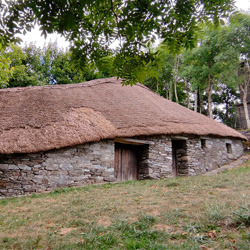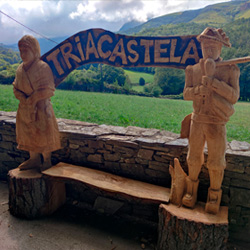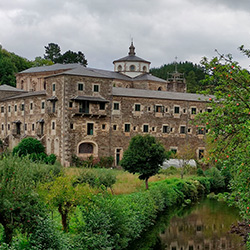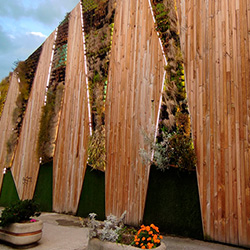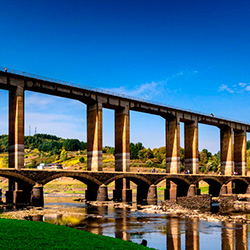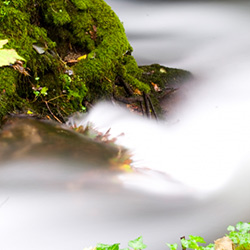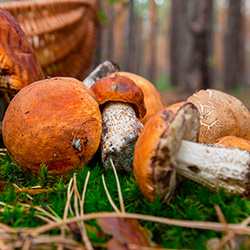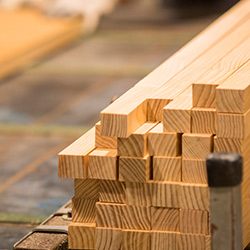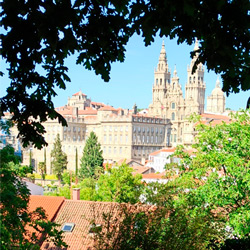PEFC on the French Way
PEFC Galicia is a non-profit association which promotes sustainable forestry management, guaranteeing they meet environmental, social, economic and ethical requirements.
The forest is part of the culture and idiosyncrasy of Galician people. 70% of our territory is forestry, so in one way or another, it plays a part in our lives, it draws our landscape, it is home to the flora and fauna, it provides with work and with a residence for rural population, it supplies food and renewable raw material, it preserves land and the water, it allows us to switch off from our everyday life and it contributes to the mitigation of climate change.
PEFC distinguishes with its hallmark all products (wood, resin, chestnuts, honey, mushrooms, biomass, textile,…), which come from certified forests, guaranteeing their traceability throughout the forest chain until the final consumer.
Thanks to the PEFC initiative in the Camino, you will understand the importance of the forests on a global and local scale. Expand your view: trees, usage, work, legends, toponymy… access each and every suggested stops, we will recommend you what to see, what to know and you will discover our forest, our industry and our way of doing things.
Between the mountains of O Courel and Os Ancares, at a height of about 1,300 m, there is a small village of pre-Roman origin which is the starting point of the Camino Francés in Galicia. Called O Cebreiro.
Looking at structures from the past is used to rediscover sustainable raw materials. Currently, wood construction plays a fundamental role in the fight against climate change, since wood is a natural and renewable material.
DIDYOU KNOW? The use of wood in construction instead of steel or concrete would reduce fossil fuel use by 19% and CO2 emissions by up to 31% (CEPE).
Architects, interior designers and designers see PEFC-certified wood as a guarantee of legal origin, since the seal guarantees that this wood is extracted from legal sources and responsibly managed forests, ensuring traceability in all links of the supply chain.
Galician forest areas are home to a very important natural heritage, prehistoric, historical, ethnographic and cultural that must be preserved.
When crossing the limit that separates the municipality of Pedrafita do Cebreiro with that of Triacastela, you will enter a Biosphere Reserve, figure of international protection that stands out for its great natural beauty and for the cultural and ethnographic wealth. It is an area of special landscape interest with ZEC (Special Conservation Area) and ZEPVN (Special Protection Area of Natural Values) spaces.
Triacastela hides in its mountains many secrets yet to be discovered, and other discoveries such as the Cova de Eirós.
Promote among forest owners and managers knowledge related to the presence of landscape, cultural, heritage or recreational values on their land and the implications that their actions may have on its conservation, is one of the many goals PEFC.
We could normally point out that forests are a shelter for plenty of species, since, according to FAO, around 80% of terrestrial biodiversity all over the world is found in forests and United Nations adds that these forests are formed by more than 60.000 tree species. But in Samos we can also appreciate that they can also be a spiritual shelter or simply a perfect place to get away from the world.
Many monasteries, such as San Xulián de Samos, are placed in forest areas, looking for solitude, far from any distraction and seeking thinking, study, retreat and prayer. But not only did they decide their location for this reason, but also forests were a source of nutrition, from hunting to fruit collection, medicinal herbs collection , wood supply for building, furniture , heat source and water harvesting.
Through the PEFC Forestry Certification System, the different habitats are preserved, regenerated and, moreover, they keep the obtainment of products, goods and services offered by forests guaranteed now and in the future.
To obtain the precious “Compostela”, you must complete at least the last 100 kilometres on foot or on horseback, the last 200 km by bike or 100 nautical miles, finishing the rest of the way on foot from the port of disembarkation. The last 100 kilometres must be done by any of the routes recognized as official, like the Camino Francés, and Sarria can be one more stage in your pilgrimage or the starting point to Santiago.
The trees allow us to travel. Travel through time, music, the transport we use or the new lives we generate.
Just by looking at the growth rings of a tree, we can tell in which year a drought occurred, if there was a fire or from which side the wind blows more. In addition, trees provide us with wood to create instruments, or to build means of transport such as boats, bicycles or railway sleepers.
So that we can continue travelling now and in the future, PEFC forest certification establishes a series of standards and controls that guarantee that the mountains are managed properly and responsibly.
The interaction between nature and human beings leads us to a constant transformation of the landscape. When you arrive in Portomarín you realize how people are able to modify landscapes, towns and stories, and Portomarín has its own. Discover it at this stop!
Forestry activity produces incalculable goods for society, such as the improvement of air and water quality, soil stability or biodiversity, among many others. Damage to the forest can require years and even centuries to be repaired, as it happens with forest fires.
Climate change is one of the influencing factors in forest fires, but the abandonment of the territory and therefore the poor management of the forest are determining factors. For this reason, promoting and strengthening rural development, adding value to natural resources and encouraging neighbouring forest communities and private owners for their sustainable use and exploitation, is one of the objectives of PEFC forest certification.
The stage from Portomarín to Palas de Rei, is the longest of the Camino Francés in Galician territory.
La Sierra do Careon, an area which protects the natural values, covers part of the municipality of Palas de Rei and your next stage to Melide. Moreover, Palas possess a wide artistic heritage and numerous archaeological remains, which many pilgrims decide to visit in the Castillo de Pambre (Pambre’s Castle).
It is essential to keep the degree of naturalness of those forestry areas considered natural and semi-natural, as well as to preserve the singular habitats, which motivate their conservation because of their particular ecological characteristics.
A non- intensive management is closer to natural processes tan an intensive one, however, the abandonment of an area can lead to a degradation of the forestry ecosystem and to an increase of the risks for its conservation, that is why it is so important to study and plan properly to achieve a balance.
The traditional Galician way of living has been characterized by a sustainable use of the territory based on the complementarity and multifunctionality of the different spaces that integrate.
Although on many occasions we do not notice it, we are surrounded by forest products. At this stop you will be able to deep into the resources provided by forests, timber and non-timber.
From the mountains, we can obtain wood to build houses, make furniture, paper for books and magazines, food containers, toilet paper and even our clothes can be made with wood fibers, but they also offer us many other resources such as medicinal plants, resin or foods such as chestnuts, walnuts, mushrooms, blackberries…
Through PEFC forest certification, we can trace sustainably managed products from the mountains to the final consumer.
O Pino is practically in the centre of Galicia, with a gentle relief, bathed on its northern slope by the Tambre River, and on the southern slope the streams direct their waters towards the Ulla basin, drawing beautiful landscapes accompanied along its course of mills, recreational areas, river beaches or hiking trails.
The forest area occupies more than half of this municipality. The forest is an essential part of the Galician economy, with a mostly rural population and where most of the forest exploited and first transformation companies are located, working in the mountains of the area and generating local employment.
Innovation and technological improvement contribute to the opening of new markets, and the forestry sector has the opportunity to be the protagonist and facilitate a circular bio economy.
Galicia is a national leader in PEFC certified responsible companies, guaranteeing its clients the legal and sustainable origin of certified forest products. Many of the forestry companies in O Pino have the PEFC Chain of Custody certification.
Trees play an essential role in the fight against pollution in cities. Compostela has many green spaces with various characteristics, from parks, gardens to forests which turn the Galician capital throughout the seasons.
Unique trees, special landscape areas, MANY THINGS TO BE DISCOVERED! in a city which has 52m2 of green area per inhabitant, it is above the recommendations of the World Health Organization (15m2).
The PEFC actively works to raise awareness about the importance of trees in city living.


















